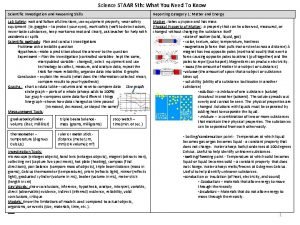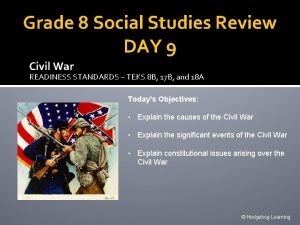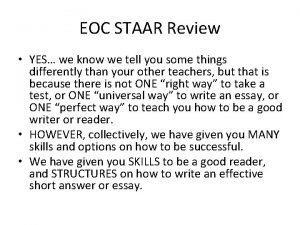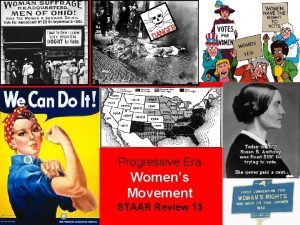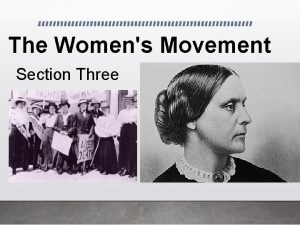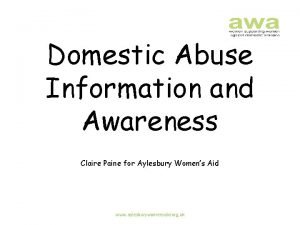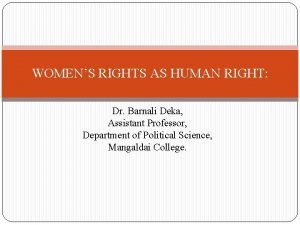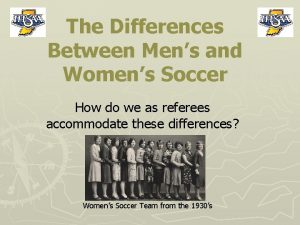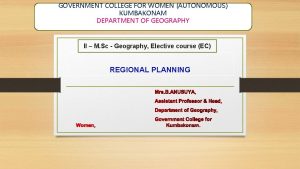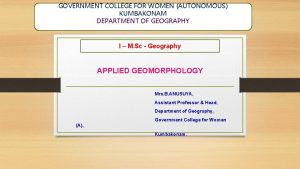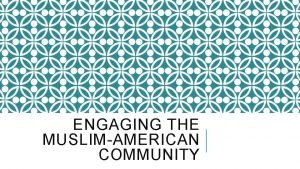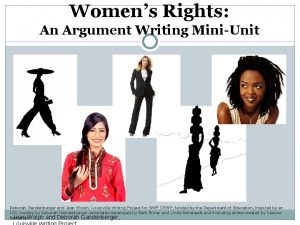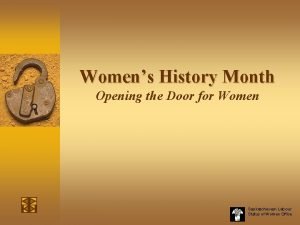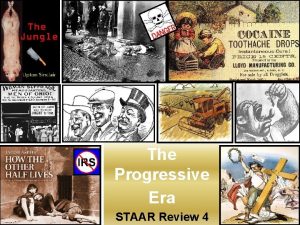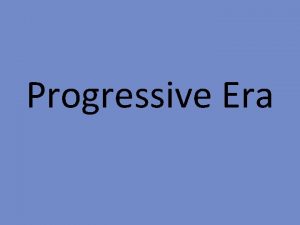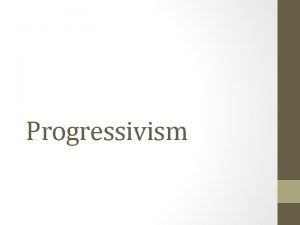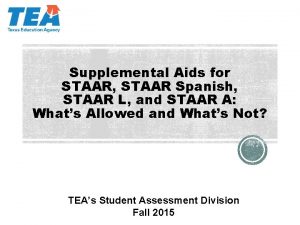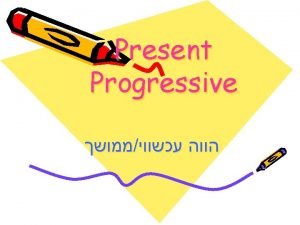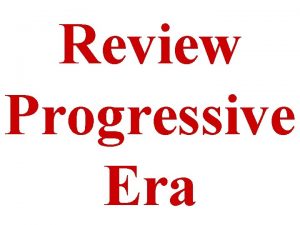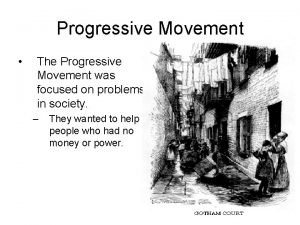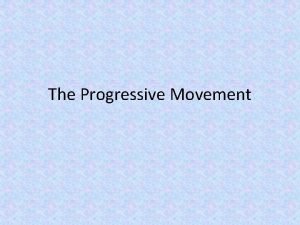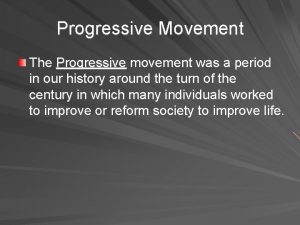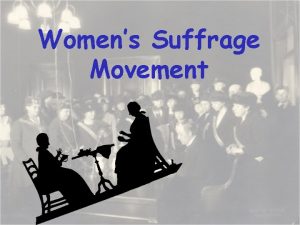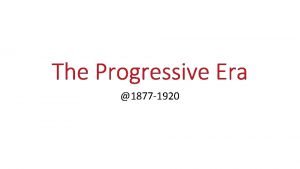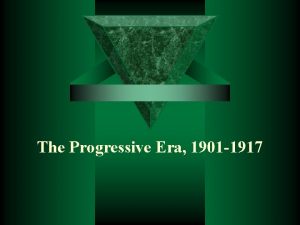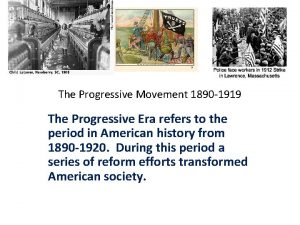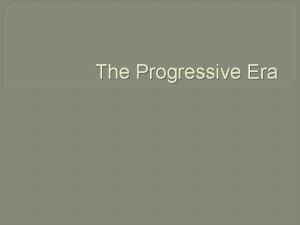Progressive Era Womens Movement STAAR Review 13 Learning






















- Slides: 22

Progressive Era Women’s Movement STAAR Review 13

Learning Objective • US. 3 (C) analyze social issues affecting women, minorities, children, immigrants, urbanization, the Social Gospel, and philanthropy of industrialists; • US. 5 (A) evaluate the impact of Progressive Era reforms, including initiative, referendum, recall, and the passage of the 16 th, 17 th, and 19 th amendments; Vocabulary Suffrage – right to vote

Proof of Learning Critical Writing / Small Group Purposeful Talk By the end of the lesson you will be expected to – • Analyze issues affecting women • Analyze how Progressive reforms gave citizens more participation in their government. • Identify women important to the suffrage movement

Women’s Suffrage Movement • In the early 19 th century, the United States was a ‘patriarchal’ society – men held the positions of authority and women were considered inferior. • Women lacked the right to vote, to serve on juries, or to hold public office. • They were excluded from public life and were left in charge of the home and children. • In most states, once a woman married, she lost control of her property and wages to her husband.

Women’s Suffrage Movement • By the middle of the 19 th century, some women began to organize to gain more rights. • In 1848, they held a convention at Seneca Falls, New York. • The convention passed a resolution that paraphrased the Declaration of Independence. • It proclaimed that women were equal to men and deserved the right to vote, or suffrage.

Susan B. Anthony • In 1872, Susan B. Anthony attempted to vote, exercising her 14 th Amendment right (citizenship). • But, a judge refused to grant her the right to vote. • In 1874, the Supreme Court ruled that women were citizens, but they couldn’t vote, because voting was not a ‘privilege’ of citizenship. • The Suffragettes were able to obtain suffrage for women living in the western states. Area in white

Women’s Suffrage Movement • But, Susan was unable to succeed in introducing a constitutional amendment requiring all states to give women suffrage. Look women • By 1890 several women’s will be suffrage groups joined together able to vote ! to form the National American Women Suffrage Assn. • This group was led by reformers: – Susan B. Anthony – Elizabeth Cady Stanton But do I have to vote for a man ?

Nineteenth Amendment • During World War I, women had taken the place of the fighting man in the work place, as women stepped up to meet the challenges of war, it became hard to deny them suffrage. • As a result of World War I and women’s involvement the U. S. Congress passed 19 th Amendment. • The 19 th Amendment stated that no state could deny a citizen the right to vote based on their sex.

Impact of the 19 th Amendment • The 19 th Amendment was a step forward in making the USA a true democracy – a system of government by the people. • But, it did not lead to dramatic changes in our political system, as women did not sweep men out of public office. • Even today many women face discrimination and are paid less than a man doing the same work.

Proof of Learning Critical Writing / Small Group Purposeful Talk By the end of the lesson you will be expected to – • Analyze issues affecting women • Analyze how Progressive reforms gave citizens more participation in their government. • Identify women important to the suffrage movement

STAAR Practice Suffragette who was arrested for voting, but continued in her quest for women’s suffrage. • • Ida Tarbell Jane Addams Sandra Day O’Connor Susan B. Anthony 1

2 STAAR Practice From which historical document was this excerpt based on? • • U. S. Constitution Bill of Rights Gettysburg Address Declaration of Independence

STAAR Practice 3 The quotation most closely represents the views of ---- • • Jane Addams Ida B. Wells Joh D. Rockefeller Susan B. Anthony

STAAR Practice 4 The first women’s rights convention was held at this location. • • Seneca Falls, New York, New York Philadelphia, Pennsylvania Washington, D. C.

STAAR Practice 5 The ideals expressed in this passage were made into reality with the passage of the ____ Amendment to the Constitution giving women suffrage in 1920. • • 16 th 17 th 18 th 19 th

STAAR Practice 6 Which of the following statements describes issues that affected women in the late 1800 s? • Women could attend school and run for political office. • Women who married could own property and vote for president. • Women had no political power and were not allowed to vote. • Women who were married controlled their own wages and had the right to vote.

STAAR Practice 7 The political cartoon displays that women were rolling over opposition. Which amendment advanced the power of women? • • 16 th 17 th 18 th 19 th

STAAR Practice 8 Which goal set at the women’s convention in Seneca Falls in 1848, was finally achieved during the Progressive Era? • Direct election of U. S. Senators by the public • Graduated income tax with the wealthy paying a higher rate • Ratification of the Nineteenth Amendment • Passage of the Pure Food and Drug Act

STAAR Practice Which conclusion is supported by information in the chart? • • Congress allowed women to vote in all elections. Before 1920, many Western states had granted women the right to vote. The U. S. Supreme Court had to approve a woman’s right to vote in each state. Women were permitted to vote in all state elections. 9

STAAR Practice 10 Using political cartoon. Why are the elephant and the donkey showing so much interest in the woman? A. She is a famous movie star of the Roaring 20 s. B. She started he own company and is rich. C. She has just recently been guaranteed suffrage. D. She is deciding which on to marry.

STAAR Practice 11 Using political cartoon. What do the donkey and the elephant represent? A. They represent political parties. B. They represent the rich businessmen. C. They represent farm animals. D. They represent different branches of the military.

STAAR Practice 12 Reform leader Susan B. Anthony declared “Failure is impossible” when describing which progressive goal? • The prohibition of the manufacture and sale of alcoholic beverages. • An amendment to the U. S. Constitution that gave women the right to vote. • The passage of the first law banning young children from factory work. • An anti-trust act that would regulate big business and restore competition.
 Dynanotes
Dynanotes Gilded age kahoot
Gilded age kahoot Reporting category 3 earth and space
Reporting category 3 earth and space Hedgehog learning 5th grade science
Hedgehog learning 5th grade science Day 9 grade 8 social studies staar review
Day 9 grade 8 social studies staar review Science staar review
Science staar review Body language staar answer key
Body language staar answer key Biology staar review
Biology staar review Jeopard animal
Jeopard animal Staar
Staar Needs of adolescence
Needs of adolescence Womens rights
Womens rights Late night womens hour
Late night womens hour Womens aid aylesbury
Womens aid aylesbury Womens right
Womens right Difference between mens and womens soccer
Difference between mens and womens soccer Womens college kumbakonam
Womens college kumbakonam Womens college kumbakonam
Womens college kumbakonam Womens right
Womens right Womens shelter edmonton
Womens shelter edmonton Womens rights
Womens rights Female genitalia labeled
Female genitalia labeled Womens history month door
Womens history month door


